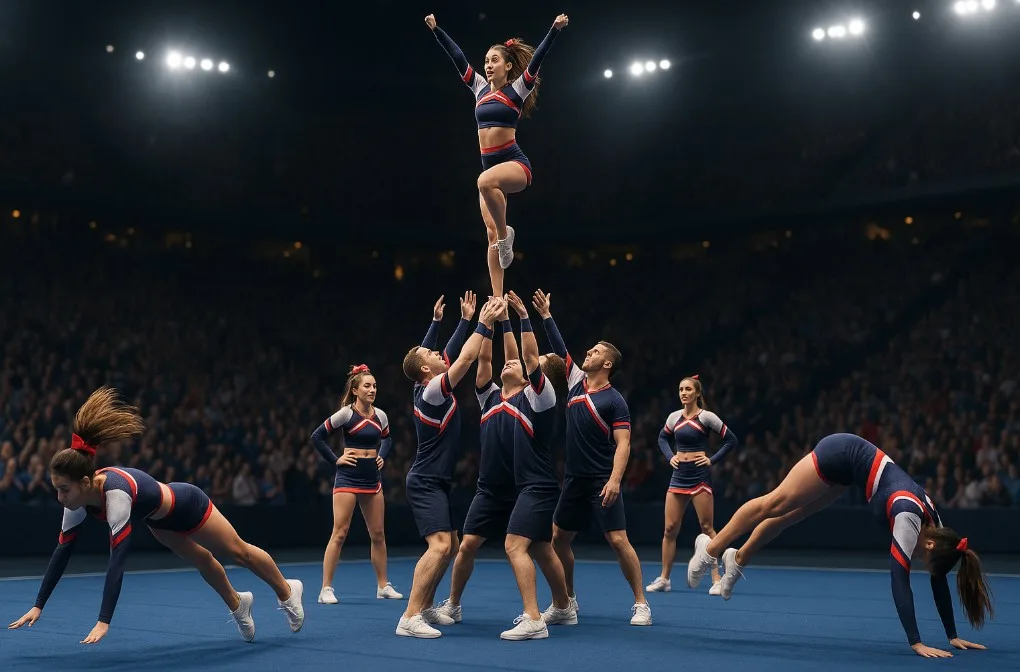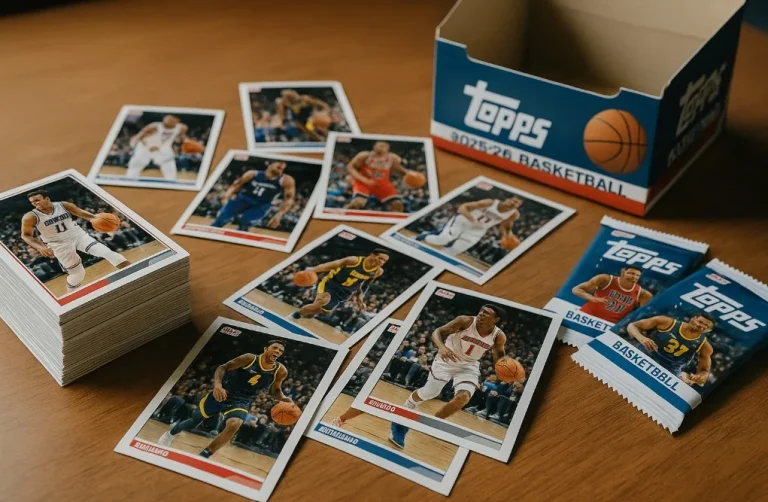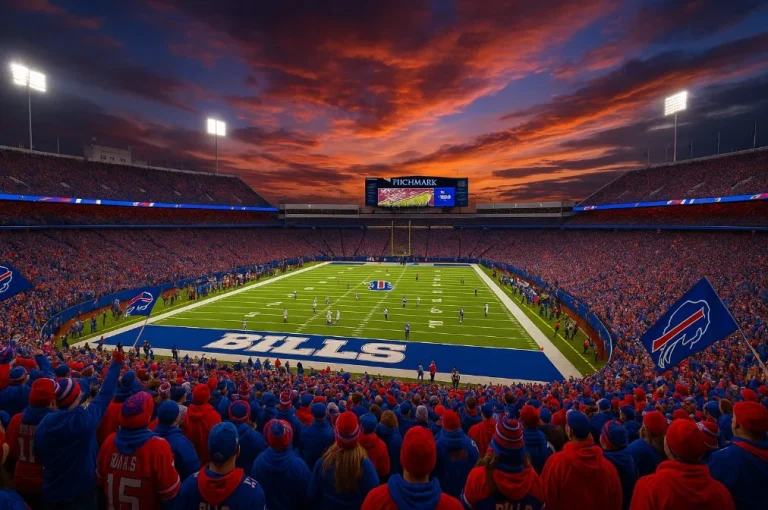Is Competitive Cheer a Sport?
Have you ever asked yourself, is competitive cheer a sport, or is it just a spirited sideline activity? For decades, cheerleading has been linked to school spirit and athletic support.
Yet modern competitive cheer has evolved into something far more demanding. With structured rules, scoring systems, national and international competitions, and physically intense training, the answer is clear: yes, competitive cheerleading is a sport.
To fully understand why, let’s explore the athletic demands, recognition, and unique features that define competitive cheer.
What Makes Competitive Cheerleading Different from Sideline Cheer?
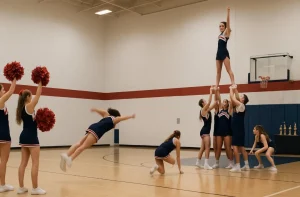
Traditional cheerleading was historically designed to boost morale and encourage athletes on the field. Sideline cheerleaders often focus on chants, jumps, and halftime routines, with the primary goal of energising the crowd.
In contrast, competitive cheerleading is not about supporting another sport. It is about being the sport.
Competitive cheerleading involves carefully choreographed routines that last a few minutes but require months of preparation. These routines blend elements of gymnastics, dance, and acrobatics, performed in front of a panel of judges.
The routines are scored based on execution, difficulty, synchronization, and creativity. While the spirit of cheer remains, the competitive aspect transforms it into a standalone sport.
How Physically Demanding Is Competitive Cheerleading?
The athletic demands of competitive cheer are often underestimated. Cheerleaders are not only dancers or performers; they are athletes in every sense.
Routines include tumbling sequences that mirror gymnastics, stunts that require strength comparable to weightlifting, and pyramids that demand precision and coordination.
Training for these routines is rigorous. Athletes spend several hours per week on conditioning, strength training, and skill development. Endurance is also critical, as routines must be delivered at maximum intensity without breaks.
For instance, a two-and-a-half-minute cheer routine is physically equivalent to running several sprints back-to-back while performing acrobatic elements.
Flexibility and balance are equally important. Flyers, who are lifted into the air, must maintain complete body control, while bases must combine power and stability to support them safely.
The level of athleticism required places cheerleaders alongside athletes in gymnastics, figure skating, and even contact sports when it comes to physical preparation.
Do Cheerleaders Compete Like Other Athletes?
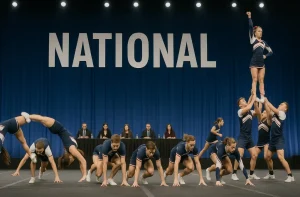
Competition is at the heart of modern cheerleading. Teams compete at local, national, and international levels, often against hundreds of other groups.
The stakes are high, with titles such as The Cheerleading Worlds or NCA College Nationals carrying prestige equivalent to championships in other sports.
These competitions are highly structured. Teams are placed in divisions based on age, size, and skill level. Judges score routines using detailed criteria, including the difficulty of stunts, execution of tumbling passes, timing of jumps, and overall showmanship.
Unlike sideline cheer, where crowd engagement is the goal, competitive cheerleading is focused entirely on measurable performance outcomes.
The level of competition also ensures that athletes approach the sport with seriousness and dedication.
Teams often travel nationally and internationally to participate, and just like football or basketball teams, they spend months preparing for a few minutes on the mat.
Are There Rules and Structures in Competitive Cheerleading?
For an activity to be classified as a sport, it must have defined rules, scoring systems, and regulatory bodies. Competitive cheerleading checks all these boxes.
The rules specify everything from the length of routines to the kinds of stunts permitted. Safety guidelines regulate how athletes can be lifted, caught, or thrown, ensuring that routines push athletic limits without endangering participants.
Age and skill-based divisions further maintain fairness, much like weight classes in wrestling or divisions in youth football.
The scoring system is equally structured. Routines are evaluated on technical execution, creativity, synchronization, and overall impression. Points can be deducted for mistakes such as falls, incomplete tumbling passes, or lack of coordination.
This formal structure makes competitive cheer directly comparable to established sports like gymnastics or diving, where athletes are also judged on precision and difficulty.
How Much Training Do Competitive Cheerleaders Undertake?
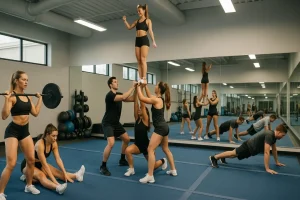
The training schedules of competitive cheerleaders reflect the seriousness of the sport. Many teams practice several times a week, with sessions lasting three to four hours.
Training includes a combination of weightlifting, endurance exercises, flexibility routines, and endless repetitions of stunts and tumbling passes.
Off-season conditioning is just as demanding. Athletes often engage in cross-training, including swimming, track workouts, or strength training, to build the stamina required for competition season.
This level of commitment mirrors that of athletes in basketball, soccer, or gymnastics, where constant physical preparation is vital for peak performance.
The sheer volume of training highlights why competitive cheerleading should not be dismissed as extracurricular activity. Cheerleaders devote themselves to year-round preparation, often at the same intensity as varsity athletes in other sports.
Is Competitive Cheerleading Officially Recognized as a Sport?
Recognition remains one of the most contentious issues in the cheerleading debate. While not all institutions recognise competitive cheer as an official sport, progress has been made at multiple levels.
Some states in the United States classify competitive cheerleading as a sport under athletic associations. Organisations such as the Women’s Sports Foundation have also formally acknowledged its legitimacy.
USA Cheer, the national governing body, even developed STUNT, a sport-specific version of cheer designed to provide athletes with more structured competition opportunities.
Globally, competitive cheerleading received a major milestone in 2021, when the International Olympic Committee officially recognised it.
This recognition positions cheerleading for possible inclusion in future Olympic Games, cementing its place as a legitimate international sport.
Why Was Cheerleading Not Always Considered a Sport?
The historical roots of cheerleading explain why it has not always been considered a sport. For decades, cheer was associated with the sidelines of basketball and football games, with the primary role being to lead chants and energise the crowd.
This entertainment-based image made it difficult for cheerleading to be seen as athletic competition.
However, the evolution of cheer has been dramatic. Today’s competitive cheerleading requires advanced tumbling skills, intricate pyramids, and physically demanding stunts that rival those seen in gymnastics.
The transformation from crowd-leading to competitive performance has shifted public perception, although remnants of the traditional view still fuel debate.
How Does Competitive Cheerleading Compare with Other Sports?
A side-by-side comparison makes it clear that competitive cheer shares many characteristics with recognised sports.
| Feature | Competitive Cheer | Gymnastics | Basketball | Soccer |
|---|---|---|---|---|
| Physical Demands | High | High | High | High |
| Rules & Scoring | Yes | Yes | Yes | Yes |
| Teamwork Required | Essential | Partial | Essential | Essential |
| Governing Bodies | USA Cheer, ICU | FIG | NCAA, FIBA | FIFA |
| Injury Risks | Moderate-High | Moderate | Moderate | Moderate |
| Official Recognition | Growing | Established | Established | Established |
This comparison demonstrates that competitive cheer meets the same standards of athleticism, structure, and competition as other sports that face no debate over their legitimacy.
What Does the Future Hold for Competitive Cheerleading?

The future of competitive cheerleading is promising. With growing recognition, greater media coverage, and continued support from governing bodies, it is moving closer to full acceptance as a mainstream sport.
Colleges and universities are beginning to acknowledge competitive cheer, and initiatives like STUNT are creating more structured opportunities for athletes.
Furthermore, the IOC’s recognition of cheerleading strengthens its case for Olympic inclusion.
Should this happen, competitive cheer would gain international visibility and recognition on par with gymnastics or figure skating, bringing greater funding and support to athletes.
Conclusion
So, is competitive cheer a sport? The answer is yes. It involves rigorous physical exertion, requires a high level of athletic skill, operates under structured rules and scoring systems, and features formal competition at every level.
While the roots of cheerleading as a sideline activity once clouded its classification, modern competitive cheer has proven itself to be a legitimate sport.
As recognition grows globally and within the United States, the athletes who dedicate themselves to cheerleading are finally gaining the respect they deserve.
FAQs
What skills are essential for competitive cheerleading?
Strength, agility, flexibility, coordination, and stamina are all vital for mastering stunts, tumbling, and synchronized routines.
Why is competitive cheer sometimes not recognized as a sport?
Its origins as a sideline activity and limited institutional recognition by groups like the NCAA have contributed to ongoing debate.
What is STUNT and how is it different from competitive cheerleading?
STUNT, created by USA Cheer, is a sport-specific version of cheer that emphasizes structured competition rather than spirit-leading.
How are cheerleading competitions scored?
Judges assess difficulty, execution, synchronization, creativity, and overall performance. Deductions are applied for mistakes or falls.
How often do competitive cheerleaders train?
Most competitive teams train several days a week, with sessions lasting hours, alongside additional strength and conditioning work.
Is competitive cheerleading dangerous?
Like other sports, it carries risks. Stunts and tumbling can lead to injuries, but strict rules and safety protocols help reduce these risks.
Could cheerleading appear in the Olympics?
Yes. Since the International Olympic Committee recognised cheerleading in 2021, the sport is on a pathway toward possible Olympic inclusion.

